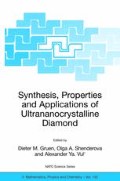Abstract
Computational studies of growth mechanisms on diamond surfaces based on C2 precursor have been reviewed. The investigations have postulated reaction mechanisms with diamond growth occurring by insertion of C2 into the C-H bonds of the hydrogen-terminated diamond surface or into π- bonded carbon dimers on dehydrogenated diamond surfaces. Reaction barriers for both growth and renucleation at (011) and (100) diamond surfaces had been calculated using quantum chemistry approaches. Preliminary results on growth mechanism involving CN precursors are also reported.
Access this chapter
Tax calculation will be finalised at checkout
Purchases are for personal use only
Preview
Unable to display preview. Download preview PDF.
References
D.M. Gruen. Nanocrystalline diamond films. Annu. Rev. Mater. Sci. 29, 211–59 (1999).
D.M. Gruen, S. Liu, A.R. Krauss, J. Luo, and X. Pan. Fullerenes as precursors for diamond film growth without hydrogen or oxygen additions. Appl. Phys. Lett. 64, 1502–04 (1994).
P. Zapol, L.A. Curtiss, H. Tamura, and M.S. Gordon. Theoretical Studies of Growth Reactions on Diamond Surfaces. In: Computational Materials Chemistry, in press
W.J Hehre, L. Radom, J.A. Pople, and P.v.R. Schleyer. Ab Initio Molecular Orbital Theory. New York: Wiley, 1987.
M. J. Frisch et al. Gaussian 98. Pittsburgh: Gaussian, Inc., 1998.
W. Kohn, A. D. Becke, and R. G. Parr. Density functional theory of electronic structure. J. Phys. Chem. 100, 12974–80 (1996).
Th. Frauenheim, G. Seifert, M. Elstner, T. Niehaus, C. Kohler, M. Amkreutz, M. Sternberg, Z. Hajnal, A. Di Carlo, and S. Suhai. Atomistic simulations of complex materials: ground-state and excited-state properties. J. Phys. Cond. Matter 14, 3015–47 (2002).
L.A. Curtiss, K. Raghavachari, P.C. Redfem, V. Rassolov, and J.A. Pople. Gaussian-3 (G3) theory for molecules containing first and second-row atoms. J Chem. Phys. 109, 7764–76 (1998).
P.C. Redfern, D.A. Homer, L.A. Curtiss, and D.M. Gruen. Theoretical studies of growth of diamond (110) from dicarbon. J. Phys. Chem. 100, 11654–63 (1996).
M. Sternberg, M. Kaukonen, R.M. Nieminen, and Th. Frauenheim. Growth of (110) diamond using pure dicarbon. Phys. Rev. B 63, 165414 (2000).
D.M. Gruen, P.C. Redfern, D.A. Homer, P. Zapol, and L. Curtiss. Theoretical studies on nanocrystalline diamond: nucleation by dicarbon and electronic structure of planar defects. J. Phys. Chem. B 103, 5459–67 (1999).
M. Sternberg, P. Zapol, and L. Curtiss. Carbon dimers on the diamond (100) surface: Growth and nucleation. Phys. Rev. B 68, 205330 (2003).
M. Sternberg, P. Zapol, T. Frauenheim, J. Carlisle, D. M. Gruen, and L. A. Curtiss, Density functional based tight binding study of C2 and CN Deposition on (100) diamond surface. Mat. Res. Soc. Symp. Proc. 675, W12.11.1 (2001).
P. Zapol and M. Sternberg, to be published.
D. M. Gruen, S. Liu, A. R. Krauss, and X. Pan. Buckyball microwave plasmas: Fragmentation and diamond-film growth. J. Appl. Phys. 75, 1758–63 (1994).
D. Zhou, T. G. McCauley, L. C. Qin, A. R. Krauss, and D. Gruen. Synthesis of nanocrystalline diamond thin films from an Ar-CH4 microwave plasma. J Appl. Phys. 83, 540–43 (1998).
D. Zhou, D. M. Gruen, L. C. Qin, T. G. McCauley, and A. R. Krauss. Control of diamond film microstructure by Ar additions to CH4/H2 microwave plasmas. J. Appl. Phys. 84, 1981–89 (1998).
S. Bhattacharyya, O. Auciello, J. Birrell, J. A. Carlisle, L. A. Curtiss, A. N. Goyette, D. M. Gruen, A. R. Krauss, J. Schlueter, A. Sumant, and P, Zapol. Synthesis and characterization of highly-conducting nitrogen-doped ultrananocrystalline diamond films Appl. Phys. Lett. 79, 1441–43 (2001).
M. Sternberg, D. A. Homer, P. C. Redfern, P. Zapol, L. A. Curtiss, to be published.
Author information
Authors and Affiliations
Editor information
Editors and Affiliations
Rights and permissions
Copyright information
© 2005 U.S. Government
About this paper
Cite this paper
Curtiss, L., Zapoll, P., Sternberg, M., Redfernm, P., Horner, D., Gruen, D. (2005). Quantum Chemical Studies of Growth Mechanisms of Ultrananocrystalline Diamond. In: Gruen, D.M., Shenderova, O.A., Vul’, A.Y. (eds) Synthesis, Properties and Applications of Ultrananocrystalline Diamond. NATO Science Series, vol 192. Springer, Dordrecht. https://doi.org/10.1007/1-4020-3322-2_4
Download citation
DOI: https://doi.org/10.1007/1-4020-3322-2_4
Publisher Name: Springer, Dordrecht
Print ISBN: 978-1-4020-3320-9
Online ISBN: 978-1-4020-3322-3
eBook Packages: Physics and AstronomyPhysics and Astronomy (R0)

